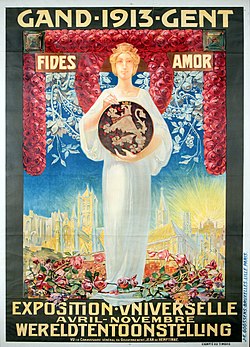Ghent International Exposition (1913)
World's fair held in Ghent, Belgium From Wikipedia, the free encyclopedia
The Ghent International Exposition of 1913 (Dutch: Wereldtentoonstelling van 1913 Gent, French: Exposition universelle et internationale de 1913 Gand) was a world's fair held in Ghent, Belgium, from 26 April to 3 November 1913.[2]
| 1913 Ghent | |
|---|---|
 Poster for the exhibition | |
| Overview | |
| BIE-class | Universal exposition |
| Category | Historical Expo |
| Name | Exposition Universelle et Internationale de Gand 1913 |
| Building(s) | Gent-Sint-Pieters railway station |
| Area | 130 hectares (320 acres) |
| Organized by | Émile Coppieters[1] |
| Participant(s) | |
| Countries | 31 |
| Location | |
| Country | Belgium |
| City | Ghent |
| Venue | Citadelpark |
| Coordinates | 51°02′16.4″N 3°43′12″E |
| Timeline | |
| Opening | 26 April 1913 |
| Closure | 3 November 1913 |
| Universal expositions | |
| Previous | Esposizione internazionale dell'industria e del lavoro in Turin |
| Next | Panama–Pacific International Exposition in San Francisco |
| Internet | |
| Website | http://www.expo1913.be/ |
History
Summarize
Perspective
A number of buildings were completed for the occasion. Notably, Gent-Sint-Pieters railway station was completed in 1912 in time for the exposition,[3] and was situated opposite the new hotel, Flandria Palace.[4] A park, Citadelpark, was redesigned for the fair. The exposition was held on an area of 130 hectares (320 acres), which was larger than Expo 58 in Brussels.[5] Various Belgian cities had a pavilion and an artificial town, called "Oud Vlaenderen" (Old Flanders) was created.[6]

The four sons of Aymon statue, depicting Reinout, Adelaert, Ritsaert and Writsaert on their horse, Beyaert, was erected on the central approach avenue to the exposition.[7]
In preparation for the exhibition, renovations were made in the centre of Ghent, including a large number of houses on the Graslei.[8][9] Some years beforen the neo-gothic St Michael's Bridge had been built to provide visitors to the exhibition with a vantage point to view the town,[10] the post office[11] and the Korenmarkt (Wheat Market) had been built, and the carved heads now arrayed around it represented the rulers who attended the exhibition (including Florence Nightingale).[10] The construction of the exhibition was controversial and ended on the eve of World War I with serious debts.[12]
During the fair, an international conference on urban planning was held, organised by Paul Saintenoy, Emile Vinck, and Paul Otlet.[1]
Belgium's first aerial postage service was operated from 1 May to 25 August by Henri Crombez during the exposition.[13]
Greek confectionery maker Leonidas Kestekides attended the fair, and then settled permanently in Belgium and founded the Leonidas chocolate company.
In the last of such type of human zoo stagings,[citation needed] part of a group of 53 Igorot tribesmen from Bontoc, Mountain Province, 28-year-old Filipino Timicheg was "displayed" and died here of tuberculosis[14] or flu.[15] A tunnel in the Gent-Sint-Pieters railway station renovation project is named after him.
Participants
The participating nations included: Algeria, Austria, Canada, the Congo, Denmark, France, Germany, Italy, Japan, Morocco, the Netherlands, Persia, Russia, Spain, Switzerland, Tunisia and the United States
See also
- Belgian general strike of 1913 (14-24 April 1913)
References
External links
Wikiwand - on
Seamless Wikipedia browsing. On steroids.
